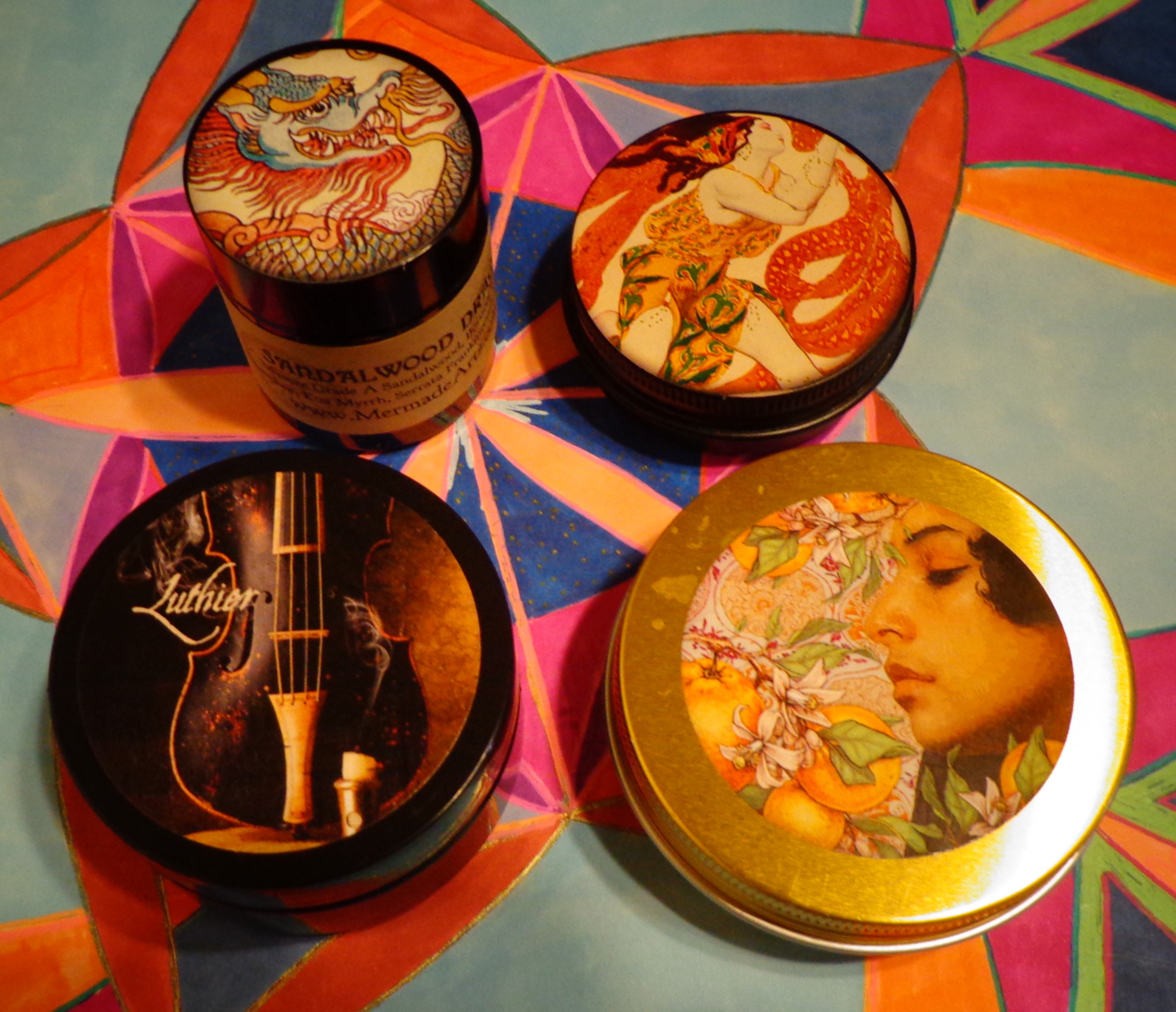
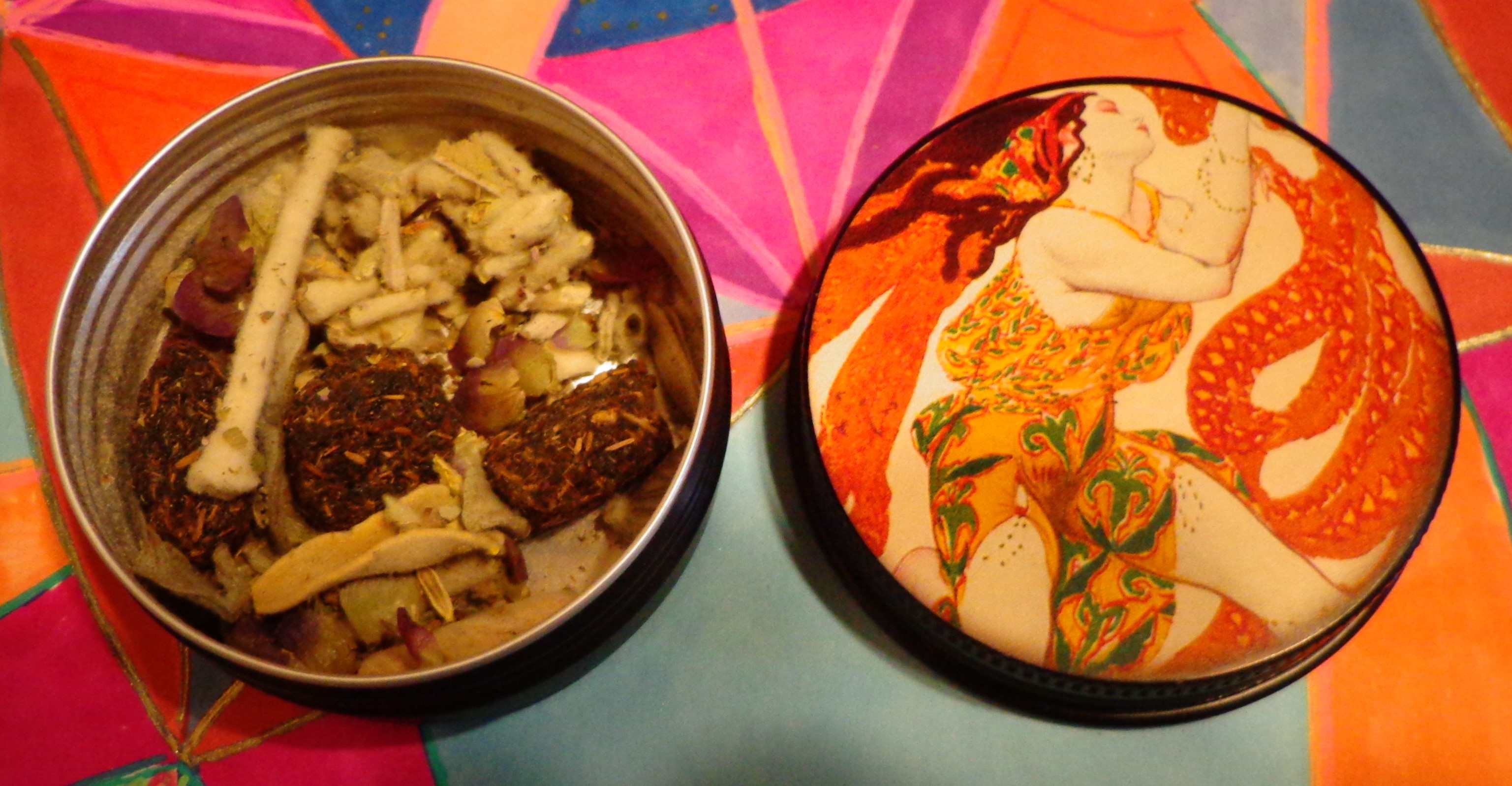 Before I took a look at the ingredients list of Bacchant, my initial impression was that it was something of a cousin to Holy Woods, as it seemed to hint a bit at the same minty notes on top. But then when I did look at them and then reheat the last piece in my sample, I felt like maybe the similarity was more the labdanum resin as there is a really obvious and clear-in-front black currant note (it reminds me of the pastilles I used to love when I was a child in England) that is the incense’s dominant front, ahead of that uniquely resinous labdanum center. This middle is something more caramel-confection sweet and I would imagine the vanilla has a lot to do with this, due to its use in cooking. There is a feeling that this is a bit close to some aspects of the Mermade kyphi (the raisins and honey I’d imagine), but I would also think the black currant is doing something analagous here to that almost wine-like scent you get in kyphis; when you tune into this the overall impression does seem quite Dionysian but equally as autumnal and season-related. There are also some similarities with some of Mermade’s green blends, although it isn’t one on its own. Overall, this has something of a feel of a fusion of a number of different directions of late, but the center of it feels quite decadent and sweet, a feeling of a wild party in swing. I also noticed on one or two occasions that the herb and flower mix the pieces come in can impart wholly different qualities on top that are quite fascinating, So certainly a unique new Mermade direction here.
Before I took a look at the ingredients list of Bacchant, my initial impression was that it was something of a cousin to Holy Woods, as it seemed to hint a bit at the same minty notes on top. But then when I did look at them and then reheat the last piece in my sample, I felt like maybe the similarity was more the labdanum resin as there is a really obvious and clear-in-front black currant note (it reminds me of the pastilles I used to love when I was a child in England) that is the incense’s dominant front, ahead of that uniquely resinous labdanum center. This middle is something more caramel-confection sweet and I would imagine the vanilla has a lot to do with this, due to its use in cooking. There is a feeling that this is a bit close to some aspects of the Mermade kyphi (the raisins and honey I’d imagine), but I would also think the black currant is doing something analagous here to that almost wine-like scent you get in kyphis; when you tune into this the overall impression does seem quite Dionysian but equally as autumnal and season-related. There are also some similarities with some of Mermade’s green blends, although it isn’t one on its own. Overall, this has something of a feel of a fusion of a number of different directions of late, but the center of it feels quite decadent and sweet, a feeling of a wild party in swing. I also noticed on one or two occasions that the herb and flower mix the pieces come in can impart wholly different qualities on top that are quite fascinating, So certainly a unique new Mermade direction here.
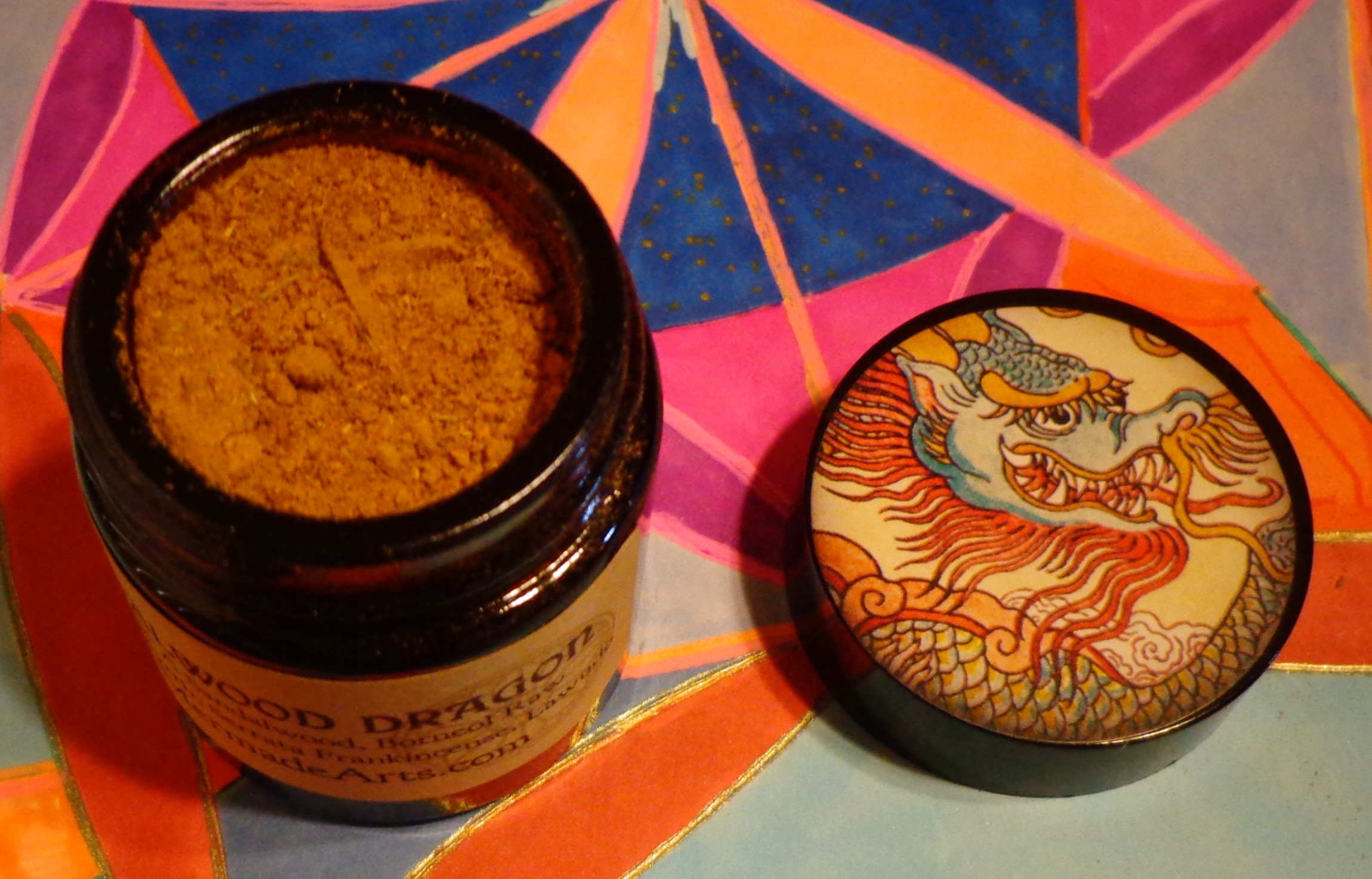 I reviewed a previous vintage of Sandalwood Dragon here. The current vintage still seems pretty close and has about as much to do with the camphor as it does the sandalwood, it’s a pairing that really brings out some unique notes. It was interesting reading my thoughts on the previous version with the lime and citrus as this one has struck me separately as more in the orange/citrus range so I am not sure if this just a new and different take on it or there’s been some different character imparted by the frankincense and myrrh mix. But if you can imagine a sort of three-way conference among the sandalwood base, the picture-perfect camphor scent and the resin mix then you’ll get some idea of where this blend is coming from and how intricately everything interacts. I have yet to get the balance right with the heater on it as it seems like a lot of the top notes go too fast if you put it up high (which you may naturally do with sandalwood), but that initial mix is extremely beautiful, amd I hope to get the hang of it soon!
I reviewed a previous vintage of Sandalwood Dragon here. The current vintage still seems pretty close and has about as much to do with the camphor as it does the sandalwood, it’s a pairing that really brings out some unique notes. It was interesting reading my thoughts on the previous version with the lime and citrus as this one has struck me separately as more in the orange/citrus range so I am not sure if this just a new and different take on it or there’s been some different character imparted by the frankincense and myrrh mix. But if you can imagine a sort of three-way conference among the sandalwood base, the picture-perfect camphor scent and the resin mix then you’ll get some idea of where this blend is coming from and how intricately everything interacts. I have yet to get the balance right with the heater on it as it seems like a lot of the top notes go too fast if you put it up high (which you may naturally do with sandalwood), but that initial mix is extremely beautiful, amd I hope to get the hang of it soon!
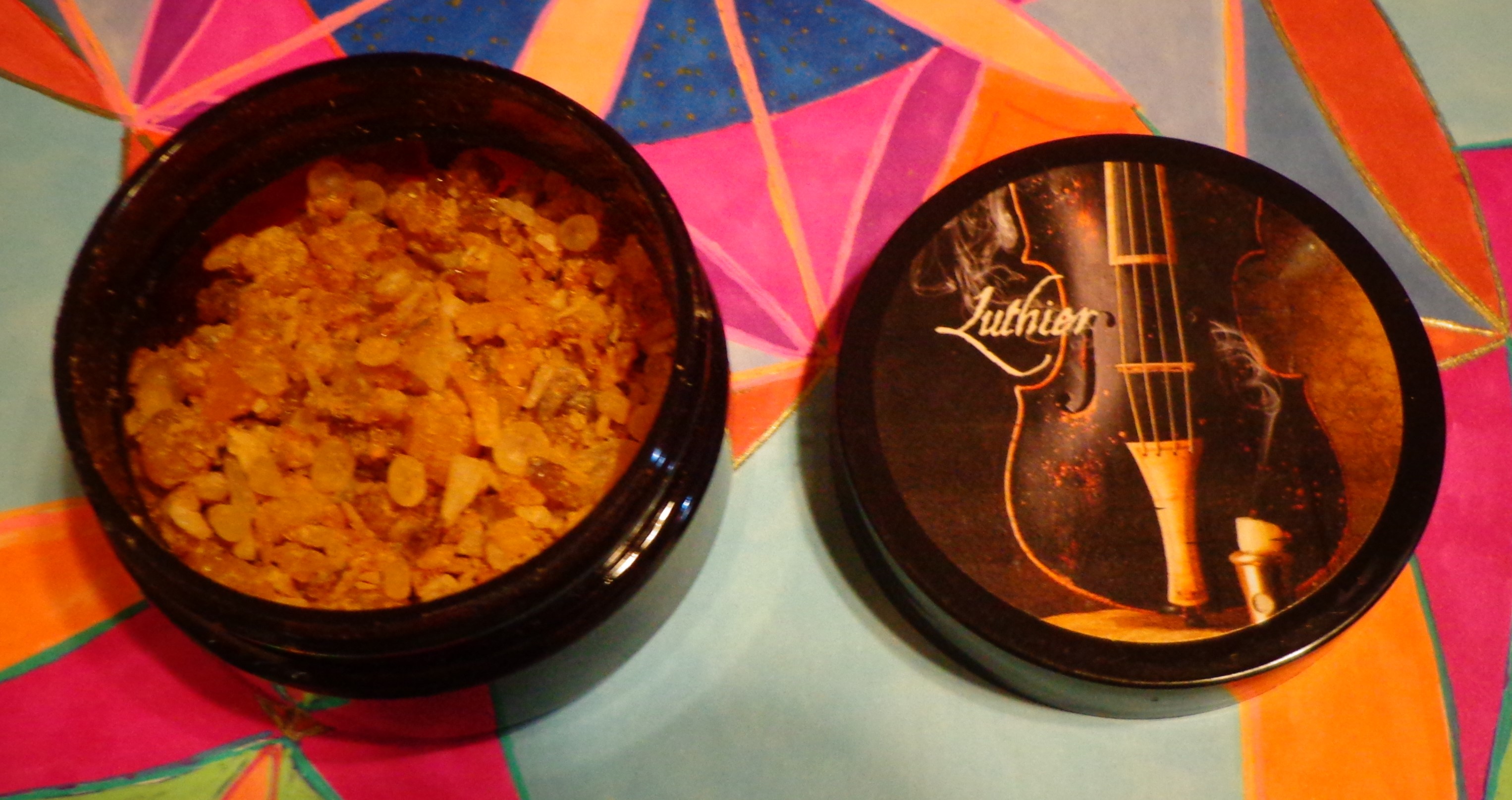 When I was young I used to bike to a record store that was next door to another store that sold stringed instruments. I wasn’t reminded of it until I first heated Luthier. On the face of it, this is an incense that actually looks almost exactly like a traditional catholic blend, but it seems mostly based on a mix of pine resin, copals and mastic, and you can actually smell all three of them quite clearly. You can find a description of the scent Kat was inspired by with this one and it really does capture an “incense [that] is created from the resins traditionally used in the crafting of violin varnish.” It’s a bit quieter than a resin mix that is catholic based which is pretty typical of these resins, but their scent really seems to match the smell of a classic instrument store. Part of it is that the resinous qualities of the wood really lean more to the sorts of turpentine-like scents you get in a wood shop, something that always makes me feel a bit nostalgic. A really wonderful and unique incense, something I am not sure if anyone has introduced to the market to date.
When I was young I used to bike to a record store that was next door to another store that sold stringed instruments. I wasn’t reminded of it until I first heated Luthier. On the face of it, this is an incense that actually looks almost exactly like a traditional catholic blend, but it seems mostly based on a mix of pine resin, copals and mastic, and you can actually smell all three of them quite clearly. You can find a description of the scent Kat was inspired by with this one and it really does capture an “incense [that] is created from the resins traditionally used in the crafting of violin varnish.” It’s a bit quieter than a resin mix that is catholic based which is pretty typical of these resins, but their scent really seems to match the smell of a classic instrument store. Part of it is that the resinous qualities of the wood really lean more to the sorts of turpentine-like scents you get in a wood shop, something that always makes me feel a bit nostalgic. A really wonderful and unique incense, something I am not sure if anyone has introduced to the market to date.
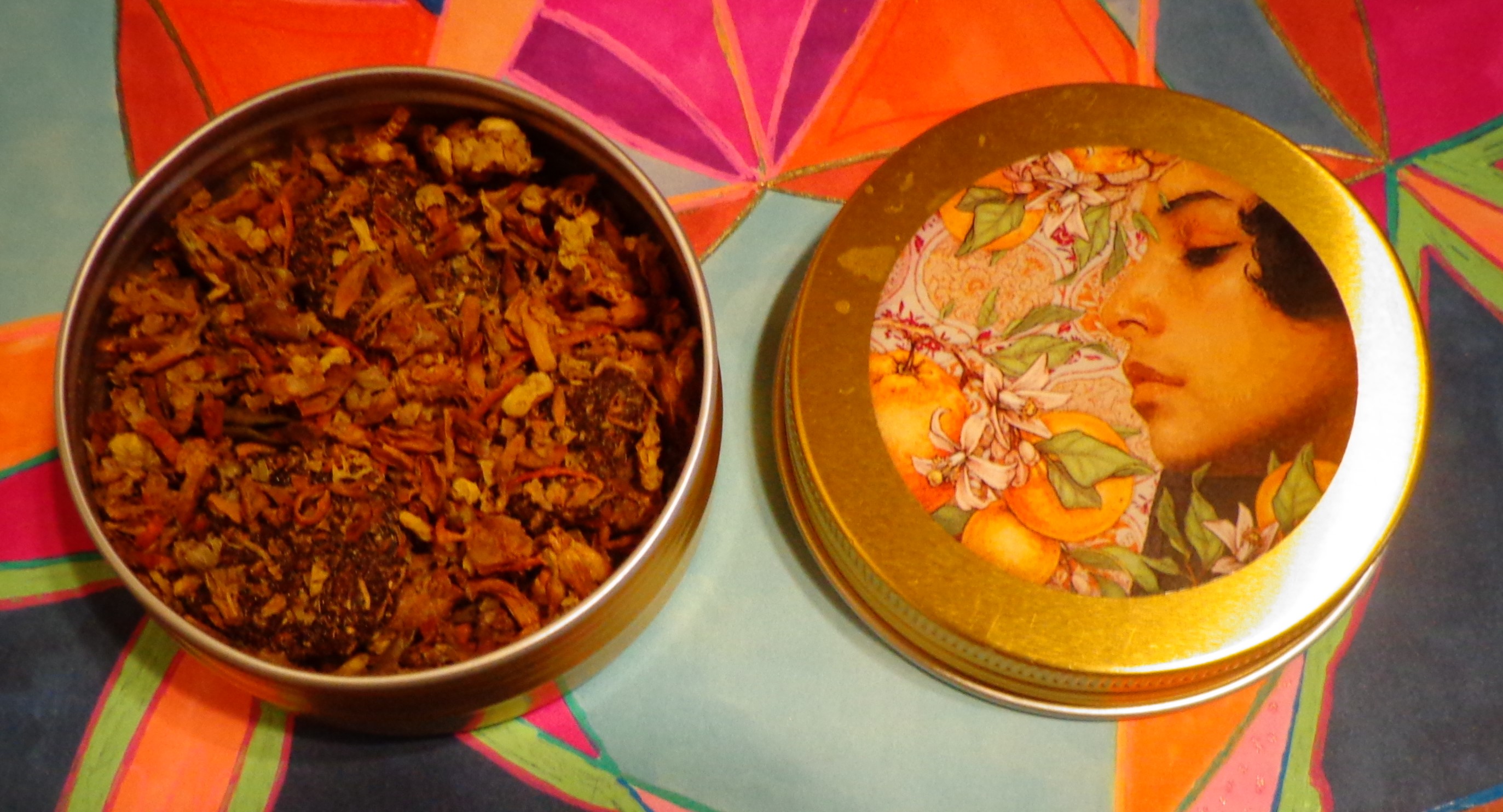 I would have probably liked Tangerine Dream whatever the blend was, let’s be honest, I’ve been a fan of the group since I was a teenager, so I love the tip on this one (and I had a neat synch reading Alastair Reynolds’ Redemption Ark, where a planet is also named Tangerine Dream, the night before I posted this!). And where I would normally argue how hard it is to get anything fruity in an incense right, Katlyn absolutely nails the tangerine scent in this one (the essential oil really does work here) and then marries it with a unique floral-fruity background into something very pretty and quite uncommon on the market at the moment. It reminds me of art where you have one central color that dissipates into other colors, all remaining complementary of the center. Also, in case you think I know what I’m doing, on my first two heats I didn’t even notice that the incense is actually the little kyphi-like pieces, because they were quite buried in the mix of flowers (in fact in this case it seems like there’s more floral than pieces)! The ingredients here are Crimson Kua myrrh, Sultan’s Green frankincense, Mysore sandalwood, benzoin, dragon’s blood resin, calamus root, oils blended with Nepali anthropogen flowers, tangerine, ruby grapefruit, blood orange, red mandarin, rose Anatolian, ginger lily, and honeysuckle melange (White Lotus). Much of this gigantic list I noticed as I added it to this review, for sure the dragon’s blood, the florals, the grapefruit, blood orange and others. It’s a very complex fruity-floral and really strikingly beautiful – you don’t just get a general tangerine scent, but it feels like you get the peel and the juice and then a whole bunch of additions that help play off the central notes.
I would have probably liked Tangerine Dream whatever the blend was, let’s be honest, I’ve been a fan of the group since I was a teenager, so I love the tip on this one (and I had a neat synch reading Alastair Reynolds’ Redemption Ark, where a planet is also named Tangerine Dream, the night before I posted this!). And where I would normally argue how hard it is to get anything fruity in an incense right, Katlyn absolutely nails the tangerine scent in this one (the essential oil really does work here) and then marries it with a unique floral-fruity background into something very pretty and quite uncommon on the market at the moment. It reminds me of art where you have one central color that dissipates into other colors, all remaining complementary of the center. Also, in case you think I know what I’m doing, on my first two heats I didn’t even notice that the incense is actually the little kyphi-like pieces, because they were quite buried in the mix of flowers (in fact in this case it seems like there’s more floral than pieces)! The ingredients here are Crimson Kua myrrh, Sultan’s Green frankincense, Mysore sandalwood, benzoin, dragon’s blood resin, calamus root, oils blended with Nepali anthropogen flowers, tangerine, ruby grapefruit, blood orange, red mandarin, rose Anatolian, ginger lily, and honeysuckle melange (White Lotus). Much of this gigantic list I noticed as I added it to this review, for sure the dragon’s blood, the florals, the grapefruit, blood orange and others. It’s a very complex fruity-floral and really strikingly beautiful – you don’t just get a general tangerine scent, but it feels like you get the peel and the juice and then a whole bunch of additions that help play off the central notes.





 Kousaido is a Japanese company of a very modern bent, carrying many of the same sorts of lines you see with Nippon Kodo. So I’ll be straight up when I say that these styles aren’t usually to my taste and this review is of a few places I cast my net looking for some things I thought I might go for or to at least get some general overview of the company. Like in Nippon Kodo and even some of Shoyeido’s lines, some of these incenses are the sort of short 2 1/2 to 3/4 inch, slightly thicker sticks that tend to be machine produced and laden with perfumed aromas. They are perhaps not targeted at traditional incense fans, although one of the boxes here perhaps presents a slightly closer pitch to wood-based scents.
Kousaido is a Japanese company of a very modern bent, carrying many of the same sorts of lines you see with Nippon Kodo. So I’ll be straight up when I say that these styles aren’t usually to my taste and this review is of a few places I cast my net looking for some things I thought I might go for or to at least get some general overview of the company. Like in Nippon Kodo and even some of Shoyeido’s lines, some of these incenses are the sort of short 2 1/2 to 3/4 inch, slightly thicker sticks that tend to be machine produced and laden with perfumed aromas. They are perhaps not targeted at traditional incense fans, although one of the boxes here perhaps presents a slightly closer pitch to wood-based scents.  You usually don’t see moderns in pawlonia boxes, but
You usually don’t see moderns in pawlonia boxes, but  These next two boxes are actually made up of multiple scents and are sampler boxes whose contents don’t appear to be imported separately. So before we go back to the short stick format, we’re going to discuss the
These next two boxes are actually made up of multiple scents and are sampler boxes whose contents don’t appear to be imported separately. So before we go back to the short stick format, we’re going to discuss the  The next Kousaido grouping falls under the name “
The next Kousaido grouping falls under the name “ Honestly, one of the main reasons I am posting about Kunjudo’s
Honestly, one of the main reasons I am posting about Kunjudo’s 
You must be logged in to post a comment.